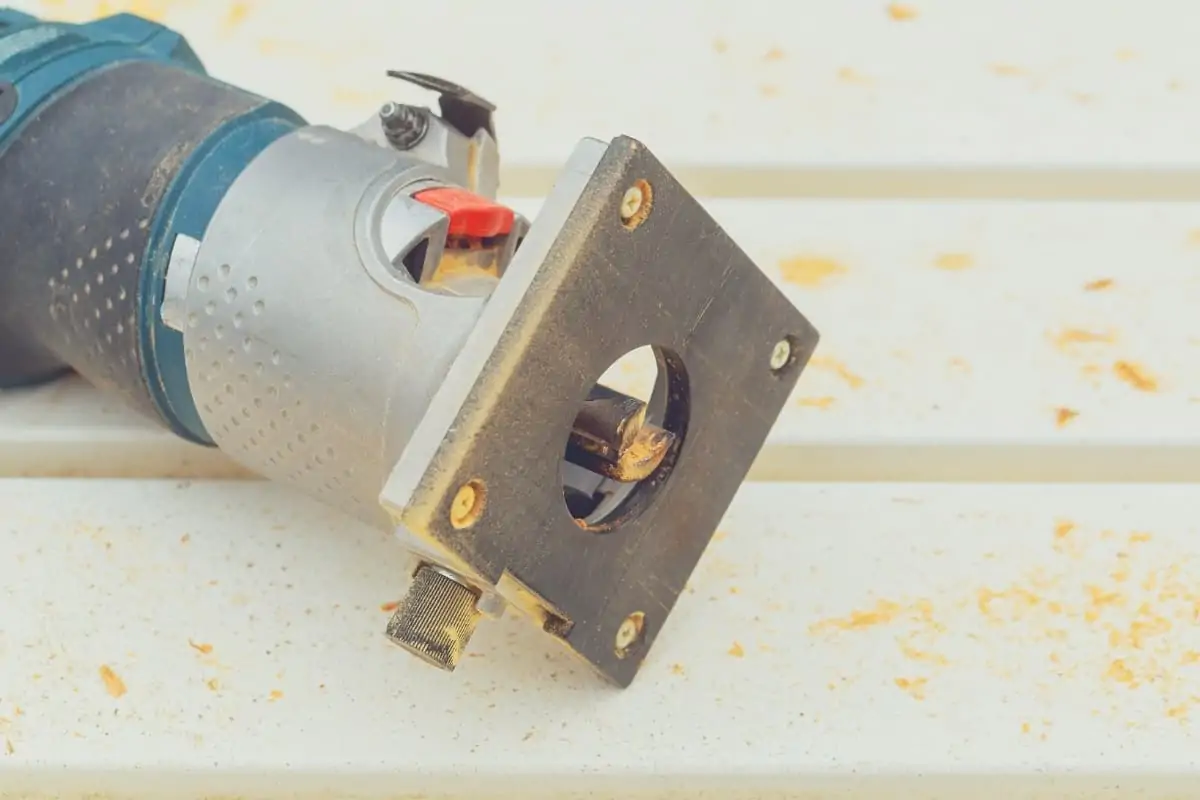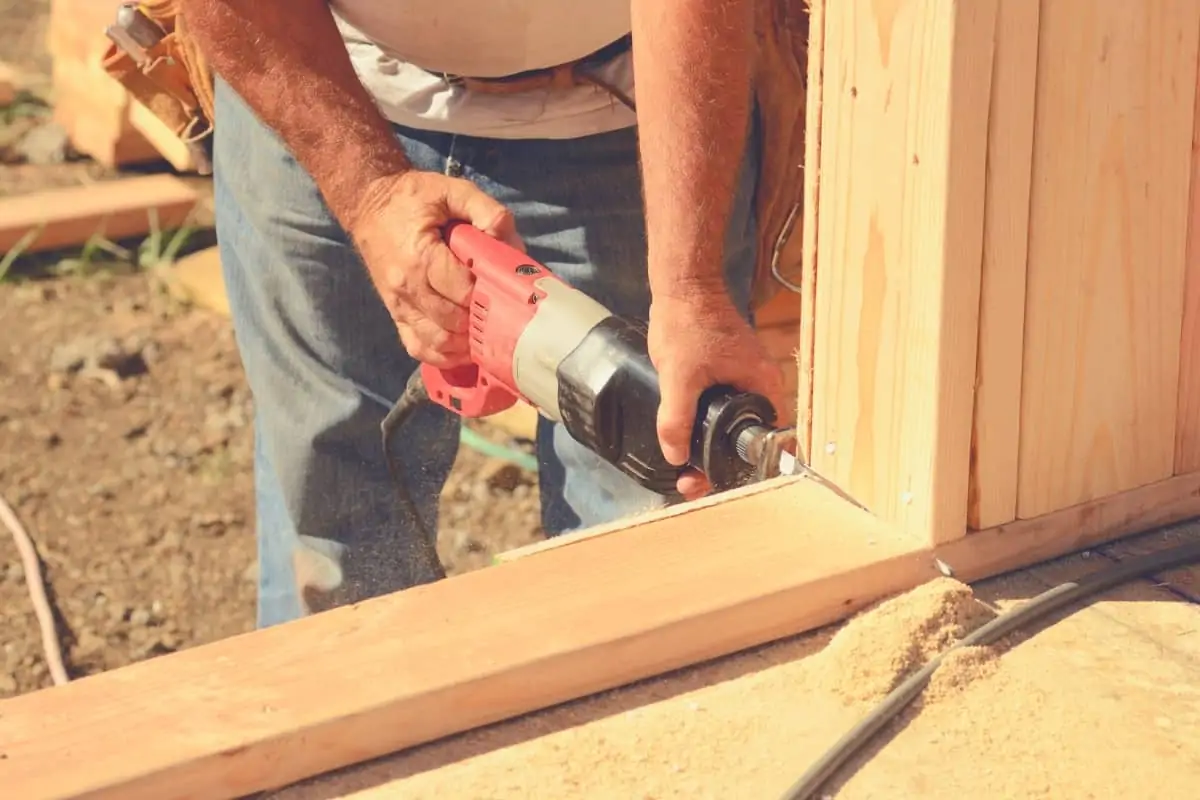Plunge routers are one of the basic tools required for woodworking. With the right base they can be used for anything from inlay to signage, but there is a huge amount of them on the market. I’m here to make your purchase a bit easier: read on for the best plunge routers and the information you need to bring the right one home.
My Top Picks for Best Plunge Router
The following 10 plunge routers are some of the best around. There’s something here for every budget and need, from a Black + Decker for light duty to a Festool suited mainly for professionals. You’ll find what you need here, no matter what your next project is.
If you’re in a hurry, here a quick round up of what I think are the best plunge routers on the market in 2023:
- DEWALT DWP611PK Plunge Router
- Makita RT0701CX7 1-1/4 HP
- Bosch 1617EVSPK Wood Router Kit
- Triton TRA001 Precision Plunge Router
- Ryobi RE180PL1G 2HP Plunge-Routing Tool
- Metabo HPT Router Kit (KM12VC)
- PORTER-CABLE 895PK Fixed/Plunge Router
- Bosch MRP23EVS Electronic Plunge Base Router
- Black + Decker RP250 Variable Speed Plunge Router
Top Pick – DEWALT DWP611PK Plunge Router
For a DIYer who needs a solid router, it’s hard to beat this little 1 ¼ HP plunge router. It also comes with a fixed base, so you won’t have to make any sacrifices if you decide to switch to a table later.
The motor has both EFC and a soft start to make it beginner-friendly. The bases are easy to switch, the plunge base is solid, and the micro-adjustments are accurate. There’s a lot more thought put into this trim-sized router than most, including a very visible base and LED lights that make it easy to see your workpiece.
This router does have a couple of issues as well. The primary one of concern is that it can overheat, burning brushes, and other parts. Just be aware of how hot the housing is, you’ll need to give it a break on very large jobs.
Overall, however, the DWP611PK is a solid set and the plunge router base is perfect for around-the-home projects and moderate work. If you’re not stuck on a full-size router, then it bears checking out.
| Max. Speed | 27000 RPM |
| Amperage | 7 |
| Plunge Depth | 2 inches |
| Collet Size | 1/4 inch |
| Weight | 6.2 lbs |
| Warranty | 3 year |
Pros
- Great micro-adjustments
- 2” of travel with the plunge base
- LED lights and clear base for great visibility
- Comes with both base types for convenience
Cons
- Prone to overheating on long jobs
- Hard to control with one hand
Overall, this is a good fit for most DIY-oriented garages. Take a look and see if it’s right for you!
Top Value Pick – Makita RT0701CX7 1-1/4 HP
Makita makes this excellent router set, combining both bases once more, that’s more affordable than many options. This 1 ¼HP router should be considered by most DIYers, and even beginning professionals on a tighter budget.
This router is a bit slimmer than most in its power class. It also features a variable speed control from 3,000RPM to 10,000RPM and easy controls for setting depth. The flat top is a nice touch as well, allowing you to invert the router on your bench when changing the bits out.
Unfortunately, the motor tends to heat up quickly, so it’s not a great option when you need to quickly finish a large job. The bigger problem to me is that it’s not as compatible with ready-made accessories like router table plates. Not many of them are made to match Makita’s design.
It’s a very respectable tool in its own right, and with a lower price than I’d expect. Those doing DIY projects around the house will probably benefit from it the most, but it should work well for hobbyists and occasional professional use too.
| Max. Speed | 30000 RPM |
| Amperage | 6.5 |
| Plunge Depth | 1 3/8 inch |
| Collet Size | 1/4 inch |
| Weight | 3.9 lbs |
| Warranty | 1 year |
Pros
- Great price for the tool’s performance
- Variable speed controls
- Easy-to-use depth adjustment
- Very slim in the hand
Cons
- Heats up a lot on long jobs
- Not as many ready-made accessories available
If that sounds like what you’re looking for, then give it a look!
Bosch 1617EVSPK Wood Router Kit
Boch makes excellent routers, and this one sometimes feels like a throwback with it’s antique lines and wooden handles. Even better, it’s a solid piece of work suitable for anyone who needs a mid-sized router set.
It features a 2 ¼ horsepower motor, variable cutting speed from 8,000 to 25,000 RPM, and precision depth adjustment that is accurate to 1/64th of an inch. It also features great electronic controls to keep it going, and both ¼” and ½” collets to use more bits.
On the downside, the handles on the plunge base are mediocre. It’s not a big deal, but they feel a bit cheap. Especially compared to the wooden handles on the fixed base. The router is also a pain to switch between bases, which is unfortunate for those who were looking to rapidly change things out.
It’s a solid option with a few flaws. The motor is perfectly sized for the home carpenter, and the downsides are offset with a moderate price.
| Max. Speed | 25000 RPM |
| Amperage | 12 |
| Plunge Depth | 2 1/4 inch |
| Collet Size | 1/4, 3/8, 1/2 inch |
| Weight | 10 lbs |
| Warranty | 1 year |
Pros
- Wooden handles on fixed base
- Set comes with both fixed and plunged base for a good price
- Smooth speed controls
- Works with bits up to ½”
Cons
- Handles on the plunge base are a bit weak
- Changing bases can be a pain
For those looking at a mid-sized plunge router, it’s worth a look to see if it meets your specifications.
Triton TRA001 Precision Plunge Router
Those looking for a full-sized plunge router should look at this one from Triton. It features a robust 3 ¼ horsepower motor, and it’s perfect for a router table. Whether or not it’s a great plunge router tends to depend on the person, however, especially with its sizable bulk.
Apart from solid core functions, it has a few extras to take note of. Side vents help keep dust from getting in the motor housing, and an automatic spindle lock. The router’s base is easy to switch back and forth between plunge and fixed settings as well.
The downside? It’s rather heavy for handheld work although it can be managed with some experience. The real letdown is that the plunge is often a bit rough, making it harder to use in that fashion.
That said, it’s a fine addition to a router table, and it’s usable by hand for those willing to put their back into it.
| Max. Speed | 25000 RPM |
| Amperage | 10 |
| Plunge Depth | 2 inch |
| Collet Size | 1/4, 1/2 inch |
| Weight | 8.5 lbs |
| Warranty | 3 year |
Pros
- Great for a router table
- Easy transition on base
- Side vents for motor housing
- Reasonable price
Cons
- Unwieldy to use by hand
- Plunge feature is sometimes rough
If your plunge router is mainly going to be on a table, I’d give it a good lookover online.
Ryobi RE180PL1G 2HP Plunge-Routing Tool
This plunge router from Ryobi is great for the price, making it a cool addition to the mid-sized routers we’ve listed. This particular model comes in at an even 2 HP and runs from 15,000 to 25,000 RPM cutting speed.
It’s a solid piece of work and has great soft-start and electronic feedback controls. It’s also got a decent chip-guard and spindle lock to make switching out bits easier.
On the other hand, it also has some troubles. The lock lever should always be double-checked, it has a bias towards opening up. It’s also rather bulky in the hand, and the handles leave a lot to be desired.
Still, it’s a solid choice for a beginner’s mid-sized plunge router. Just don’t expect it to be a miracle worker.
| Max. Speed | 25000 RPM |
| Amperage | 10 |
| Plunge Depth | 2 inch |
| Collet Size | 1/4, 1/2 inch |
| Weight | 8.5 lbs |
| Warranty | 3 year |
Pros
- Good price
- Powerful motor
- Great EFC and soft start
- High RPM
Cons
- Cutting depth setting is sometimes finicky
- Handles have poor ergonomics for the bulk of the tool
Does a budget mid-sized router fit the bill for you? Take a closer look online.
Metabo HPT Router Kit (KM12VC)
Metabo is a continuation of the Hitachi brand, producing the same tools with a different color scheme. This is a fine 2 ¼HP router with ergonomic handles and both types of base included.
The first thing to take notice of is the excellent, ergonomic handles. It’s also quite a bit quieter than most options, sitting at just under 80dB when running. You may still want hearing protection, but it’s a nice touch.
On the other hand, the router lacks some final polish. The plunge base needs to be “worn in” or the rods sanded depending on how you feel about the sticky movement. It also has a cheap feel in the hand.
For an affordable mid-sized plunge router, the Metabo HPT kit isn’t a bad option. Just be aware that it’s not a professional pick either.
| Max. Speed | 24000 RPM |
| Amperage | 11 |
| Plunge Depth | 2 3/5 inch |
| Collet Size | 1/4, 1/2 inch |
| Weight | 7.3 lbs |
| Warranty | 5 year |
Pros
- Great handles
- The kit comes with both kinds of base
- Quiet running for a router
- Affordably priced
Cons
- Plunge base is a bit sticky at first
- Has a cheap feel overall
If you’re thinking this one fits the bill for your needs why not get a closer look?
PORTER-CABLE 895PK
Porter-Cable’s 895PK router is another mid-sized pick, chiming in at 2 ¼HP and a motor that runs 10,000 to 23,000 RPM. It’s a heavy-duty tool, and well-suited for heavier use than most consumer options. It probably won’t make the cut for extensive heavy use, however.
It has most of the modern conveniences, including a soft start and spindle lock for easy bit changing. This kit also comes with both bases, and it’s a good router when it comes time to use a table with a fixed base.
This is still a consumer-grade router, for the most part, unlikely to stand up to heavy professional use. It’s really just a matter of some parts being made of plastic. The plunge is also a bit jerky, but it seems to wear in with enough use.
For DIY usage, however, it remains a good option. Especially if you need something larger than a trim router in the garage.
| Max. Speed | 23000 RPM |
| Amperage | 12 |
| Plunge Depth | 2 1/4 inch |
| Collet Size | 1/4, 1/2 inch |
| Weight | 13.5 lbs |
| Warranty | 3 year |
Pros
- Powerful motor
- Above-the-table cutting depth adjustments
- The kit comes with both bases
- Decent price for a mid-sized router
Cons
- Plastic parts can fail easily, reducing durability
- Plunge can be problematic
While it’s not the only game in town, it’s definitely worth a look for the DIY-minded.
Bosch MRP23EVS
Bosch has delivered with this plunge router, which is either high-consumer grade or low-professional grade depending on who you ask. What I know is that it’s a solid, decently priced router that has a 2.3HP motor.
The outer design is good, with everything holding very solid. It has variable speed control and the usual features. The handles are also particularly nice, and it’s lighter than many of the competitors since it comes in at a bit over 12 pounds. The LED work lights are also a nice touch.
There are a couple of issues. My main problem with it is that it’s hard to access the motor for repairs, there’s no external access and it takes Torx bits to open the top of the tool. It also lacks a shield on the user side, which means chips can fly at you.
Still, these are minor issues for many users. For heavy DIY use, I’d say that Bosch has hit the mark.
| Max. Speed | 25000 RPM |
| Amperage | 15 |
| Plunge Depth | 3 inch |
| Collet Size | 1/4, 1/2 inch |
| Weight | 12.6 lbs |
| Warranty | 1 year |
Pros
- Powerful motor
- Durable housing
- LED work lights
- Relatively lightweight
Cons
- No user-facing chip guard
- Motor access is problematic
If you’re thinking it might be a good fit, why not see for yourself?
Black + Decker RP250 Variable Speed Plunge Router
No list of tools is complete without a Black + Decker. Their reputation for great consumer-grade tools is high, despite the disdain you’ll hear from professionals. They’re solid tools, but not the type that you’ll be making a living with.
It’s a small router, running around 1.4HP, with a variable speed control running from 8,000 to 27,000 RPM, although it will only take ¼” bits. It also has great ergonomics, although it’s a bit heavy. Add in the low price and it’s easy to see why it’s a hit with the DIY crowd.
The downside? It’s a consumer-grade tool. The motor bogs down easily, the plunge could be a lot smoother, and the guard gets in the way of changing bits sometimes. You’re looking at a bit of inconvenience, especially for regular usage.
The Black + Decker RP250 is exactly what I’d expect from the brand’s tools: it’s a solid, no-frills router that’s great for DIY. Professionals and serious hobbyists will want to find something more sturdy and can safely give this one a pass.
| Max. Speed | 27000 RPM |
| Amperage | 10 |
| Plunge Depth | 2 inch |
| Collet Size | 1/4inch |
| Weight | 10.7 lbs |
| Warranty | 2 year |
Pros
- Low priced
- Good ergonomics
- Easy-to-see base
- Great RPM range
Cons
- Feels underpowered and bits often get bogged down
- Not robust enough for daily use
If a small, simple router is what you need for your DIY hobby, check it out online!
Things to Consider When Choosing the Best Plunge Router for Your Job.
Picking the right tool is never as easy as we’d like. The following information will help you figure out exactly what you need.
What is a Plunge Router?
Plunge routers have a spring-loaded base designed to allow you to push the motor and bit downwards. It makes for a flexible base since you can cut from the middle of the workpiece as well as the sides.
If you only have a single router, you should opt for a plunge-base router. They’re cool little machines and the sheer amount of woodworking possibilities opened with one is impressive.
The main drawback is that using a plunge router with a router table can be difficult. It depends on the individual router’s model, some are much better for this than others. The difficult bit is usually the springs in the router base, but it can also lead to a limited area to work. Unless you have a table designed for a plunge router, you may want to invest in a fixed base for using a router table.
Most routers can be converted back and forth by changing out the part, even on a tighter budget you may not necessarily need to choose just one. If you do have just one base available, a plunge base just has more capabilities during any free-hand routing.
Power and Speed
Routers vary a lot in power, and in this case, more powerful motors also mean a bigger tool.
For most at-home use a trim router in the 1 ¼HP to 2HP range is often best. They’re quite small compared to the bigger models, which does limit their potential for use on projects. For cleaning things up and small projects they’re a good match.
A mid-size router in the 2HP to 3HP. It’s a good size for a dedicated carpentry router. With a plunge router, it’s enough to make large signs and decorative patterns in most materials without an issue.
On the other hand, there are also 3HP and higher models which are “full-sized.” These routers are mainly used for cabinet making and other intensive, heavy use. They’re also most often used with a table. If you head down this route, you’ll end up with a powerful but unwieldy tool.
If you’re buying European tools from a brand like Festool, the power rating for the routers may be in watts. 1500W is roughly 2HP, and you can find a calculator online.
Weight And Size
Weight and size are tied to the motor’s power. More powerful motors are simply heavier, even when all other weight is accounted for.
Still, it pays off to look for a lightweight model if you’ll be using the router by hand. A router that is lighter in its weight class will make your life a lot easier during long sessions.
If you’re using a router table the weight and size don’t matter, at least as long as it fits.
Ergonomics
How a router fits your hand matters as much as the weight in real-world use.
There are two big factors in a router’s handling. The angle of the grips should allow your wrists to sit naturally. The handles should also be designed to accommodate your grip. Look for a good grip, with space for your fingers.
For larger routers, ergonomics are even more important. There’s nothing quite like lugging a heavy tool that’s awkward to grip throughout your project.
Features to Look for in Your Plunge Router
Once you have the right size, and some decent ergonomics, you’ll need to look into the nuts and bolts of the matter. The following are all things to keep an eye out for when you’re picking the right tool.
Variable Speed
Some cheaper routers are single speed, but you’ll want something that varies in speed if you’re planning on serious woodworking. Different woods react better to bits at different speeds, doing clean work with a router often means finding the right RPM for the workpiece.
It’s not a must-have feature. Most work fine on projects in readily available MDF or pine lumber even without control.
If you plan on working with things like Purpleheart or African Gaboon, however, then you need tight speed controls. In that case, smooth speed control, rather than just a couple of set speeds, is the best way to go.
Vacuum Port
Routers create a lot of sawdust, which gets in the air and on the workpiece. The solution is a good vacuum port, allowing you to hook up a shop vac for dust extraction.
Some work better than others, but you still need to make sure the adapter is the right size for your vacuum. If not, you may need to purchase another adapter to allow for easy dust extraction.
Electronic Feedback Circuitry
Many electric tools have some form of EFC, but for a router, it’s a game-changer.
A router works best at a consistent speed, and the complex circuits used ensure the torque is even to the force being applied when you’re cutting. In practice, this translates to the router not bogging down unless you really go overboard, it also means that variable RPMs are more accurate.
Consistency is everything in woodworking, and a good plunge router will have ECF to help you make smoother cuts.
Spindle Lock
Spindle locks make changing router bits much easier. The old-style of hold meant using two wrenches, and often busting knuckles, each time you needed to change things up.
A spindle lock is a button that’s pushed, keeping the central shaft of the router in place. Spindle locks allow for a single wrench to be used, saving time and effort when you need to get the next bit in.
They’re very common on modern routers, and there’s no excuse not to find one. They do represent a possible failure point on a router, but it’s uncommon as long as you’ve made sure you have a quality tool in the first place.
Soft Start
Soft start sounds simple: it just means the motor spools up to speed instead of just jumping into full RPM.
It’s a nice feature on some tools, but even a small router has a powerful motor and the sudden jump and increase in torque is disconcerting.
Meanwhile, a soft start gives you a tiny bit of time to get your grip right before the motor is spooled all the way up. It just makes using a router easier overall, and it can prevent a lot of newbie mistakes.
Above the Table Adjustment
If you’re planning on using a router table, you’ll want an above-the-table adjustment.
In these cases, the router has access to the height adjustment while inverted for use in a router table. Otherwise, you’ll have to go crawling under the table each time you need to make an adjustment.
If you’re only planning on working free-hand with a router, it’s not a concern. You may want to look for it anyway in case you change your mind in the future, however.
Router Table Compatibility
Technically, any router can be table-mounted if you’re willing to make your own base plate and table.
Most people opt for a commercial table, however, which means you need to be sure that the base plate can be used with your router. Most plates have an easy-to-find list for compatible models.
Once again: a plunge router can be used with a table but it’s not ideal. A fixed-base router is a better idea for most tables and uses, but there are builds specifically for plunge base models.
Conclusion
There’s a lot to finding the best plunge router for your next endeavor, but you can now do it with confidence. It’s really a matter of the right combination of size, power, and features to do what needs to be done. Anything else is just gravy.












